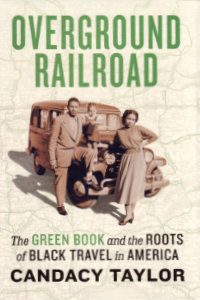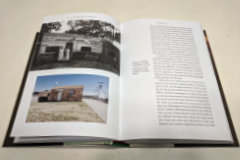 “This is not a book about the history of road-tripping and black travel”, is the first sentence of the last paragraph of the introduction. That’s something I knew long before I read it. It was something Candacy Taylor said early in the presentation I attended in Indianapolis back in February. It may even have been something she said during another presentation of hers I attended back in 2016. I discovered Taylor the same way she discovered the Green Book. Well, not exactly the same way. She learned of the Green Book while doing research for a Moon Travel Guide on Route 66. I learned of Candacy Taylor as a mere attendee at a conference on the historic road. Research for the book was well underway when Taylor spoke at that conference in Los Angeles but Overground Railroad: The Green Book and the Roots of Black Travel in America was still a concept. It was a reality when she spoke in Indianapolis, and that’s where I acquired my copy.
“This is not a book about the history of road-tripping and black travel”, is the first sentence of the last paragraph of the introduction. That’s something I knew long before I read it. It was something Candacy Taylor said early in the presentation I attended in Indianapolis back in February. It may even have been something she said during another presentation of hers I attended back in 2016. I discovered Taylor the same way she discovered the Green Book. Well, not exactly the same way. She learned of the Green Book while doing research for a Moon Travel Guide on Route 66. I learned of Candacy Taylor as a mere attendee at a conference on the historic road. Research for the book was well underway when Taylor spoke at that conference in Los Angeles but Overground Railroad: The Green Book and the Roots of Black Travel in America was still a concept. It was a reality when she spoke in Indianapolis, and that’s where I acquired my copy.
Another phrase that caught my ear at the Indianapolis presentation and which I subsequently read in the book is this: “I wasn’t interested in presenting the Green Book as a historic time capsule.” Maybe the reason I noticed the phrase was that, without actually being aware of it, that is exactly how I saw the Green Book. The book, published between 1936 to 1967, identified businesses where Negro travelers were welcome. A too often true assumption was that they were not welcome in any place not listed. The Civil Rights Act of 1964 did not make racial discrimination disappear, but it did make it illegal. By the time I became aware of the book, it had not been published for decades and I figured it had been more or less the same throughout the time it was published. In my mind, the Green Book essentially was a historic time capsule.
The book was no doubt historic, but it was not a sealed capsule. If pressed, I would have known that the book must have grown over the years and that listings and advertisers would have come and gone. Taylor meant much more than that. There were changes in the book’s overall tone that were related to changes in society and vice versa. She uses changes in the Green Book as a timeline to frame changes in the world at large. It isn’t a hard link and the two certainly don’t move in lockstep. Societal changes just aren’t that tidy. But the editions of Victor Green’s book pace the chapters in Taylor’s.
One of the bigger Green Book changes Taylor covers occurred with its return at the end of the Second World War. The guide was not published during the war, and when it returned in 1946 it was bigger and better than ever. Not only was the book enlarged, its tone was changed a bit, too. Serious articles about the situation of blacks in American society appeared along with information, such as a listing of black colleges, not exactly associated with travel. In a chapter based on the 1946 and ’47 editions, Taylor says, “This comprehensive list of colleges elevated the Green Book from a travel guide to a political weapon.”
Another big step came in 1952 when the guide’s name was changed from the Negro Motorist Green Book to the Negro Travelers Green Book. Train travel by blacks had already been included starting in 1950. Travel by airplane and other means would be covered in the future.
In a chapter linked to the 1957 and ’58 editions, Taylor addresses what is almost certainly a big reason she felt the need to stress that, “This is not a book about the history of road-tripping.” The chapter is titled “The Roots of Route 66”, and she uses Route 66 examples to explain why blacks have virtually no nostalgia for the classic American road trip, but the story is essentially the same for every other highway, too. While it’s very much an understatement, the following line does sort of sum up the chapter: “[T]he experience of driving Route 66 was not the same for everyone.”
 Overground Railroad is heavily illustrated. Taylor’s research for this project included cataloging and visiting businesses listed in the Green Book, and several of her photographs of sites that remain appear throughout the book. She also includes some personal photos. Numerous historic photos along with reproductions from the Green Book accompany the text. A section in the back of the book lists surviving “Green Book sites” and includes Taylor’s photos of many. It is followed by a section with reproductions of every known Green Book cover other than the very first edition of 1936.
Overground Railroad is heavily illustrated. Taylor’s research for this project included cataloging and visiting businesses listed in the Green Book, and several of her photographs of sites that remain appear throughout the book. She also includes some personal photos. Numerous historic photos along with reproductions from the Green Book accompany the text. A section in the back of the book lists surviving “Green Book sites” and includes Taylor’s photos of many. It is followed by a section with reproductions of every known Green Book cover other than the very first edition of 1936.
Victor Green hoped that “There will be a day sometime in the near future when this guide will not have to be published.” That day came, technically, when the 1964 Civil Rights Act became law. There was just one more Green Book published before it shut down permanently. But reality has never quite matched the technical equality of the Civil Rights Act. The first chapter of Taylor’s book, in which she discusses the risks and difficulties of Negroes driving during the early years of the Green Book, is titled “Driving While Black”. It’s a title that could have come from yesterday’s newspaper. Maybe it did. In her introduction, Taylor asks the standard road trip question, “Are we there yet?” then answers with a whole book that tells of progress but ends up with a solid “No.” It is not, however, a hopeless “No”. The “Author’s Note” near the book’s end talks of the challenge and is followed by a “What We Can Do” list.
Overground Railroad: The Green Book and the Roots of Black Travel in America, Candacy Taylor, Harry N. Abrams, January 7, 2020, 9.8 x 7 inches, 360 pages, ISBN 978-1419738173
Available through Amazon.

It is a terrific book! Was great meeting Candacy and seeing you at the Indianapolis book signing.
Oh yeah, I was quite impressed with the book. There is/was an exhibit based on her project planned for the National Freedom Center this fall. When that happens, you may just have to come to Cincinnati.
Pingback: New Stuff to Look At | Denny G's Road Trips Blog